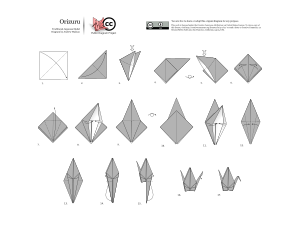Akira Yoshizawa
Akira Yoshizawa ( Japanese 吉澤 章 , Yoshizawa Akira ; born March 14, 1911 in Kaminokawa, Tochigi Prefecture , Japan ; † March 14, 2005 in Ogikubo , Tokyo , Japan) was a Japanese origami master. He is considered the founder of modern origami. He developed over 50,000 models, only a few hundred of which are recorded in his numerous books. In 1983 he received the Order of the Rising Sun from the Japanese Emperor Hirohito .
Life
Akira Yoshizawa was born on March 14, 1911, in Kaminokawa, Tochigi Prefecture , Japan , into a peasant family. At the age of 13, the trained blacksmith took a job in a factory in Tokyo . When he was promoted to draftsman in the 1930s , he taught apprentices using origami. In 1937 he quit to work full-time as an origami artist. For the next 20 years he lived in great poverty and earned his living selling tsukudani, a Japanese dish.
In 1944, Isao Honda published "Origami Shuko", which also showed work by Yoshizawa. In 1951 he appeared in the Japanese magazine "Asahi Graph", which increased his popularity. In 1954 Yoshizawa published his first book Atarashii Origami Geijutsu (Eng. "New Origami Art"). His diagram system first appeared in this work . This publication also improved his financial situation. A little later, in the same year, he founded the International Origami Center in Tokyo.
The architect and art collector Felix Tikotin organized his first overseas exhibition in 1955 at the Stedelijk Museum . In 1956 he married Kiyo, who also acted as his manager and taught origami herself. In March 1998, Yoshizawa had the opportunity to host the world's largest origami exhibition in the Louvre in Paris.
Akira Yoshizawa died on March 14, 2005, his 94th birthday, in Ogikubo Hospital of complications from pneumonia .
Services
He invented his own system for printed folding instructions. The individual folding steps are shown as diagrams with the help of various arrows and lines. This made it possible for the first time to record and pass on more complex models. It was quickly adopted by butterflies all over the world and expanded to today's standard, the Yoshizawa-Randlett system .
Yoshizawa also developed many origami techniques, including what is known as wet folding . The paper is moistened before folding, which enables round and plastic shapes. Wet folding is often seen as the innovation that made it possible to develop origami from a custom to an art form.
Works (selection)
- Atarashii Origami Geijutsu , Origami Geijutsu-Sha 1954
- Origami Reader I , Ryokuchi-Sha, 1957
- Dokuhon, Vol.1 (Origami Tokuhon), 1973, ISBN 4-8216-0408-6
- Sosaku Origami (Creative Origami), Nippon Hoso Kyokai 1984, ISBN 4-14-031028-6
- Dokuhon, Vol.2 (Origami Tokuhon), 1986
- Origami Dokuhon II (Origami Reader II), Kamakura Shobo 1986, ISBN 4-308-00400-4
literature
- Obituary the London Times (English)
- Peter Engel : Origami from Alligator to Zen, Hugendubel 1991, ISBN 3-88034-510-4
Web links
- Appreciation of Yoshizawa from David Lister (English)
- Obituary - compiled by David Brill ( Memento from November 25, 2012 in the Internet Archive ) (English; PDF; 2.6 MB)
Individual evidence
- ↑ Peter Engel: Origami from Alligator to Zen, Hugendubel 1991, ISBN 3-88034-510-4 , p. 38
- ↑ Peter Engel: Origami from Alligator to Zen, Hugendubel 1991, ISBN 3-88034-510-4
- ^ Robert J. Lang : Origami design secrets. Mathematical methods for an ancient art. Reprint, AK Peters Ltd., Wellesley (Massachusetts / USA) 2007, ISBN 1-56881-194-2 . P. 13
- ↑ a b c List of Yoshizwa's books on the British Origami Society (BOS) website
| personal data | |
|---|---|
| SURNAME | Yoshizawa, Akira |
| ALTERNATIVE NAMES | 吉澤 章 (Japanese) |
| BRIEF DESCRIPTION | Japanese origami master |
| DATE OF BIRTH | March 14, 1911 |
| PLACE OF BIRTH | Kaminokawa, Tochigi Prefecture , Japan |
| DATE OF DEATH | March 14, 2005 |
| Place of death | Ogikubo , Tokyo , Japan |

